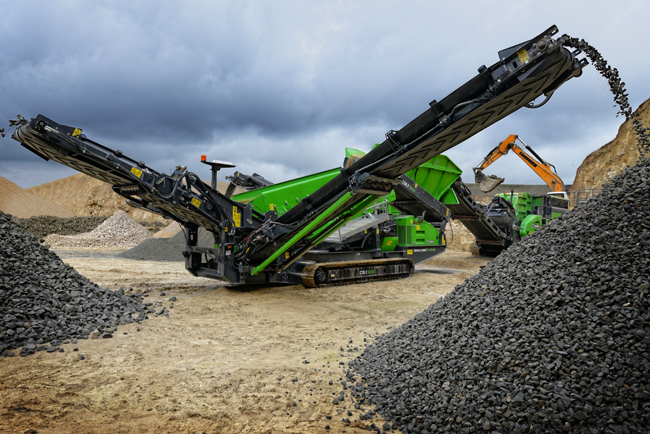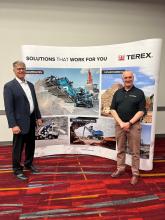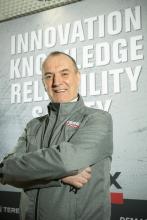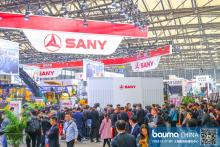
A leaner Terex Corporation is placing greater emphasis on its Terex Materials Processing business, a business keen to innovate and grasp technological advances to best meet its quarrying customers’ present and future needs.
‘Creative destruction’ is a term coined in the early 1940s by Austrian-American economist Joseph Schumpeter to describe how capitalist competition drives out weaker companies and rewards stronger ones. It remains a popular theory in global business circles and came to mind at the
The impressive plant line-up at Hillhead 2018 was also an example of how Terex Materials Processing is now taking a much larger role in shaping Terex Corporation’s future, following the sale of the material handling & port solutions (MHPS) business to Konecranes in spring 2017, and the 2016 sale of the corporation’s UK & India-based compact construction companies to Mecalac.
“We now have three key segments – Aerial Work Platforms, Cranes and Materials Processing – and a more focused portfolio,” says John Garrison, Terex Corporation’s CEO and president. “The much larger and much more important role of Materials Processing within Terex Corporation is a great thing. Kieran [Hegarty] and his team do a great job. It’s a good industry and we’ve got a broad range of equipment.
“As a corporation we are looking at all our internal processes and asking how we can be easier to do business with from a customer’s perspective.
“Under the heading ‘Execute to Win’ we are also looking at our strategy development, our commercial excellence and our talent development. I’ve been on the road doing strategy reviews with our segment presidents. I’ll be back on the road in September spending three to four days doing our talent reviews.”
Garrison says Kieran Hegarty, president of Terex Materials Processing, and his team are looking at Terex’s commercial excellence around distribution channels.
“It makes sense as most of Materials Processing’s business goes through distribution channels. The team are doing a good job with that.
“We are also working really hard on life cycle solutions and parts and service. The most important thing for the customer is having the right part in the right place at the right time, so that their machine is up and running and generating revenue. We’ve just hired a new executive to run that side of our business.
“Strategic sourcing is another important area for us. In the market we are in now, where demand for equipment has improved across all our businesses, we need to ensure the continuity of supply. We are expanding our parts supply base and working with fewer suppliers that can help us achieve our business objectives. We spend as a corporation US$3 billion on direct and indirect materials. Materials Processing, historically, has leveraged its materials spend, but we really haven’t done that across Terex as a whole. We will be working very hard on that.”
Garrison notes strong growth, in particular, in the global aerial work platforms and materials processing markets. “Kieran and I spend a lot of time travelling around the world. I have just come back from Australia and the MP business has come back nicely after several very difficult years.”
Garrison says that the restructure of Terex Corporation in the last couple of years will lead to greater investment in product research and development across all its key business segments.
Terex’s 2018 trading performance appears to support the switch to a leaner business model. Second quarter sales of US$1.4 billion equated to a 19% rise on the same period of 2017. The Terex MP business segment – which includes Fuchs [material handlers], Terex Ecotec [construction and demolition waste plant], CBI [horizontal wood grinders, shredders & chippers], and Terex Concrete Products, as well as the quarrying plant brands - was a strong contributor to overall company results with sales of US$319 million -14% higher than last year.
The growth was driven by solid global demand for crushing and screening products, Fuchs material handlers and environmental equipment. Backlog for the business segment at the end of Q2 2018 was US$393 million, up 75% compared to 1 April to 30 June last year. This indicates positive momentum for the remainder of 2018.
Among new Terex MP business line models on show at Hillhead 2018 (26-28 June) was
Under the heading ’60 Years of Passion and Innovation’, Terex Finlay marked its 60th anniversary at Hillhead 2018 with a large model line-up including the new compact and aggressive J-1160 jaw crusher.
Terex MPS was at the show with its new MC1000 cone crusher. The plant has an all-roller bearing design said to increase crushing capacity, with the model’s modularity making it quick and easy to assemble.
EvoQuip showcased its new compact yet highly productive Cobra 290R impact crusher and Colt 1000 scalping screen.
In contrast, the giant new Aggwash 300 from Terex Washing Systems is a machine capable of up-to-300tonnes/hour screening, scrubbing, sizing and sand recovery for recyclable aggregates, that runs on one modular chassis. At Hillhead 2018, the brand also showcased Aquaclear, Terex’s first water management treatment system, said to meet the growing need for water management due to new environmental legislation being introduced globally.
Hillhead 2018 also featured some of Terex Materials Processing’s new multi-branded conveyors. Having listened to Garrison paint a broad picture of how Terex Materials Processing fits into the leaner but still highly ambitious Terex Corporation growth strategy, Hegarty was keen to talk about the evolution of Terex Materials Processing brands’ equipment offerings.
“When you come to a major show like Hillhead, that takes place every two years, it is important that you are here with new models to exhibit – and we have been showcasing new equipment across all our brands. We spend a significant amount of money on research and development.”
Garrison adds: “As a corporation, one of our aims has been to reduce our general and administrative expenses in order to plough more money back into R&D.”
Focusing on Terex Materials Processing’s development of its spare parts and plant servicing capabilities, Hegarty continues: “We’ve made large capital investments. We have a new very large consolidated parts warehousing and distribution hub in Dungannon [Northern Ireland]. We are also in the process of putting in a large distribution hub in Hosur, just south of Bangalore in southern India. That will probably be completed by the end of this year.”
Hegarty is also keen to stress Terex Materials Processing’s work on plant telematics. “One of the key reasons we are investing in telematics is to improve parts and service provision. With the data from plant telematics, we can better plan servicing.
“The materials processing industry is quite competitive, and we think the investment we’ve put into telematics is giving us a competitive advantage.
“Anyone can put on a telematics device. The difference is making it relate to real-world benefits. The type of data we are getting means that, and this is what we are trialling with our Powerscreen and Terex Finlay brands, we can go to any customer at any moment in time and say ‘we can give you a standard report once a week or once a month which gives you details of your plant’s production volumes and fuel consumption’. More importantly, particularly with regard to crushing, the report can be tied into predictive maintenance where we can then tell them that based on average readings from the plant’s last ten days of operation, its next service is due in, say, ten days. We can also predict when crusher parts, including bearings, will wear out and plan the fitting of replacements.”
Continuing on the theme of telematics innovation, Garrison says: “Innovation is incredibly important. It is the juice that keeps things flowing. We want to be innovative but innovative in a way that solves a customer’s problems.”
There has been a significant rise in global demand for larger mobile crushers and screeners capable of greater hourly production output, as many quarry operators and contractors look to produce either the same or greater volumes of final aggregate product, with fewer machines, thus lowering production cost per tonne.
“The broad macro trend is that plants are getting bigger as well as more capable. An obvious gap in our brands’ mobile plant range is in ultra-large crushers and screeners. We are working to fill this space and a couple of larger plant models will, hopefully, be coming onto the market within the next 12 months. They will be capable of processing 800 to 900 tonnes an hour of material, depending on the feed.
“The move to bigger crushers and screeners ties in with the move to bigger and longer conveyors. One of the biggest costs for a quarry operation is double handling of material. If you can reduce the amount of loader and haul truck movements, you also improve site safety.”
Hegarty, who, along with Garrison, was speaking to Aggregates Business Europe during Hillhead 2018, says that he also sees huge potential in the two-year-old EvoQuip brand’s range of compact quarrying plant. EvoQuip unit sales are tipped by the brand’s management to rise by an eye-catching 55% in 2018, compared to last year.
“Markets change. Ten years ago there were just a couple of smaller players in the compact plant market. It was not an attractive enough segment. Now there are more and more contractors doing crushing and screening and you think ‘that’s an area that we want to be in’.”
The Terex MP president says the business line is keen to meet growing demand, particularly in continental Europe and the UK, for recycled aggregates. He believes plant from Terex Washing Systems (TWS) and Terex Ecotec, the latter being used to convert construction and demolition waste into recycled aggregates, leaves Terex MP and Terex Corporation well set to cater for this section of the building materials market.
“Terex Ecotec is one of Terex’s fastest growing brands,” explains Hegarty, adding, “we have invested significant numbers in the brand’s R&D and have three models here at Hillhead – including the new TBG 630 high-speed shredder. We see the broad recycling field as a growing market and you’ll see us over the coming months investing in additional manufacturing space for Terex Ecotec, and accelerating investment in its plant R&D.”
Commenting on the global aggregates recycling sector, Garrison adds: “The global regulatory framework is changing and driving the aggregates business towards more recycling activity. This is important and a good macro trend, but it’s a broad sector and you need to pick and choose where best to participate.”
Another sub-sector in the aggregates world is the rise in demand for manufactured sand. Hegarty says this is a trend he has been following closely. “I’ve noticed how manufactured sand is becoming more important in markets such as India and China, due to a shortage of access to natural sand. We make VSIs [vertical shaft impactors – used for manufactured sand production], but our VSI business isn’t big. There is a lot of early-stage study going on about making manufactured sand without any water, to avoid putting dirty water back into rivers and polluting them. I know companies like Metso are speaking publicly about manufactured sand, but we have no plans at this stage to get more involved in this area.”
With its over 12 billion tonnes/year aggregates demand, China is a hugely exciting market for quarrying plant original equipment manufacturers (OEMs). Powerscreen entered the Chinese crushing and screening market in 2017, following a successful showing at bauma China 2016 construction and quarrying exhibition in Shanghai. The Terex MP brand is, this year, building on encouraging unit sales in 2017 and is in the process of expanding its Chinese distributor network.
“We are going as planned in China,” says Hegarty. “The market for mobile crushing and screening plant is not big yet, but the overall crushing and screening market in China is huge. I think we will have to go bigger in terms of our manufacturing facilities there, just as we are doing in India.
“Terex Corporation has established a big presence in China through its Genie [aerial work platforms and lifts] brand. It’s been highly successful there and generated significant revenues. It has created building blocks that we can use for other brands.”
Garrison adds: “In the developing markets the management teams are far more important than the footprint you have – and we have strong management teams in those markets.”
After a 35-minute conversation, Garrison and Hegarty are off at speed to their next Hillhead 2018 appointment. It is a fitting metaphor for the pace of change at Terex Corporation, with expectations raised about new quarrying plant from Terex MP brands in 2019. With bauma Munich, the world’s biggest construction and quarrying equipment exhibition, taking place 8-14 April 2019, we are unlikely to have to wait too long to see some of the results of Terex’s greater focus on the development of its Terex MP business line.








